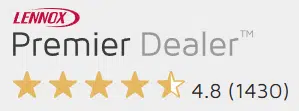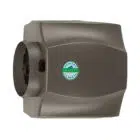
Table of Contents
When it comes to ensuring comfort and energy efficiency in your Canadian home, the right HVAC system is the key to your coziness and well-being. And, for sure, one of the main things you are worried about is the new HVAC system cost. In this comprehensive 2023 HVAC installation pricing guide, we’ll delve into the factors that affect new HVAC system costs in Canada and provide you with the information you need to make informed decisions about your home’s heating and cooling.
Average HVAC Installation Costs in Canada
Understanding the average HVAC installation costs in Canada is the first step in planning your home’s heating and cooling system upgrade. While these costs can vary considerably based on numerous factors, including your location and the type of system you choose, we would like to provide you with generic pricing for HVAC unit installation to help you plan your budget more effectively.
Central Air Conditioning: On average, the installation of a central air conditioning system in Canada can range from $3,500 to $7,500 and more. This cost includes equipment, labor, and any necessary materials or permits.
Furnaces: Furnace installation costs typically fall within the range of $2,500 to $6,000+. However, the final price can fluctuate based on the type of furnace (e.g., gas, electric, oil), size, and complexity of the installation.
Heat Pumps: Installing a heat pump, which provides both heating and cooling, may cost anywhere from $3,000 to $10,000 or more. Factors like the system’s efficiency and whether it’s ducted or ductless can affect the price.
Ductless Mini-Splits: Ductless mini-split systems, known for their flexibility, generally range from $3,000 to $6,000+ for installation. The number of indoor units and the system’s capacity are key price determinants.
Obviously, you should consider these prices as the starting point. Further, we will take a look at the important factors that can affect the new HVAC system cost significantly.
Factors Affecting HVAC Installation Costs

When it comes to HVAC systems installation costs, various factors can cause fluctuations. In this part of our guide, we’ll consider in detail these factors, such as home size, layout, energy efficiency, local climate, labor complexity, and equipment quality, to help you better understand your specific circumstances.
Type of the HVAC System
The type of HVAC system you select is one of the most significant factors impacting the cost of HVAC replacement in Canada. Let’s take a closer look:
- Central Air Conditioning: Ideal for whole-home cooling, central air systems come with their own unique costs depending on the AC type.
- Furnaces: Essential for heating homes in winter, furnaces’ costs can differ based on type (gas, electric, oil), size, and efficiency rating.
- Heat Pumps: Offering both heating and cooling, heat pumps provide versatility but may have varying installation expenses.
- Ductless Mini-Splits: These systems are known for their flexibility but come with installation costs that depend on your specific requirements.
Home Size and Layout
The size and layout of your home play a pivotal role in determining installation costs. Larger homes may require more extensive ductwork, additional heating or cooling zones, and larger capacity systems. Conversely, smaller homes often entail simpler installations. When assessing your home, consider the square footage, number of rooms, and the presence of multiple floors.
Energy Efficiency
Opting for an energy-efficient HVAC system can lead to long-term cost savings. Energy-efficient systems may have higher upfront costs but can significantly reduce monthly utility bills. Factors to consider include the system’s SEER (Seasonal Energy Efficiency Ratio) for cooling and AFUE (Annual Fuel Utilization Efficiency) for heating. Government incentives and rebates may also be available for energy-efficient upgrades.
Local Climate
Canada’s diverse climate zones impact HVAC system choices and the cost of HVAC replacement. In regions with extreme cold, such as the Canadian prairies, a robust heating system is essential. Conversely, areas with hot summers may prioritize cooling solutions. It’s essential to select an HVAC system that aligns with your local climate’s demands.
Labor and Installation Complexity
Installation complexity varies based on your home’s existing infrastructure and the chosen HVAC system. Retrofitting an older home with new ductwork can be more labor-intensive and costly than installing a system in new construction. Custom installations, unique architectural features, and challenging access can also affect labor costs.
Quality of Equipment
The quality of HVAC equipment is a crucial consideration. While higher-quality systems may come with a higher initial price tag, they often offer better energy efficiency, reliability, and longevity. Investing in quality equipment can result in lower maintenance and operating costs over time.
Ductwork
If your home has existing ductwork, its condition and suitability for your new system can impact costs. Ductwork may require cleaning, sealing, or modifications to accommodate a different system or layout. In some cases, homes without existing ductwork may need ductless or mini-split systems, which have unique installation costs.
Maintenance and Warranty
Factor in ongoing maintenance costs and the warranty coverage offered by the manufacturer or installer. Regular maintenance can extend the lifespan of your HVAC system and reduce the likelihood of costly repairs.
If you need a professional consultation with HVAC experts who will help you determine the HVAC unit installation cost in your particular case, reach out to us via the link below.
Types of HVAC Systems and Their Costs

Now, it’s time to jump to the main part of our article and look at the various types of HVAC systems commonly used in Canadian homes. We will provide you with detailed insights into the new HVAC system costs associated with each so that you can make informed decisions about your home’s upgrade. So, let’s dive in!
How Much Does It Cost to Install a Central Air Conditioning
Central air conditioning systems provide whole-home cooling, making them a popular choice for those seeking consistent indoor comfort during the sweltering Canadian summers. The cost of installing central air conditioning in your home can vary widely, typically ranging from moderate to high. Factors influencing the cost include the size of your home, the complexity of ductwork modifications, and the efficiency of the system.
Type of Central Air Conditioning System | Installation Cost Range |
|---|---|
Standard Central Air Conditioning | $3,000 – $7,000+ |
High-Efficiency Central Air Conditioning | $5,000 – $10,000+ |
Furnace Installation Price in Canada
Furnaces are the backbone of Canadian heating systems, keeping homes warm and comfortable during the chilly winter months. The cost of furnace installation varies based on factors such as the type of furnace (gas, electric, oil), size, and efficiency rating. Generally, furnace installation costs fall within a moderate to high range.
Type of Furnace | Installation Cost Range |
|---|---|
Gas Furnace | $2,500 – $7,500 |
Electric Furnace | $2,000 – $5,000 |
Oil Furnace | $3,000 – $8,000 |
High-Efficiency Furnace | $3,500 – $9,000 |
Find more detailed pricing for furnace installation depending on different factors in our previous article via the link below.
https://thehvacservice.ca/how-much-does-a-furnace-installation-cost/
Heat Pumps Installation Expenses in Canada
Heat pumps are versatile systems that provide both heating and cooling, making them a practical choice for year-round comfort. Installing a heat pump typically falls within a moderate to high range, with costs influenced by factors like the system’s efficiency, capacity, and whether it’s a ducted or ductless system.
Type of Heat Pump | Installation Cost Range |
|---|---|
Air Source Heat Pump | $3,000 – $7,000 |
Ductless Mini-Split Heat Pump | $2,500 – $7,000 |
Ground Source (Geothermal) Heat Pump | $10,000 – $30,000 |
Find out how much will it cost to install a heat pump in Canada depending on other factors via the link below.
https://thehvacservice.ca/how-much-does-it-cost-to-install-a-heat-pump-in-canada/
How Much Ductless Mini-Split System Installed Costs?
Ductless mini-split systems offer flexibility and energy efficiency, making them suitable for various home configurations. Installing ductless mini-split systems usually ranges from moderate to high, depending on factors like the number of indoor units, the complexity of the installation, and the efficiency of the system.
Type of Ductless Mini-Split System | Installation Cost Range |
|---|---|
Single-Zone Ductless Mini-Split | $2,000 – $5,000 |
Multi-Zone Ductless Mini-Split | $4,000 – $10,000 |
If you need more personalized information regarding the HVAC unit installation cost, contact us right now via the link below, and we will be happy to help you.
Effective Ways to Save on HVAC Installation

As the cost of HVAC replacement can be a significant investment, it’s natural to seek ways to save. Thankfully, several strategies can help you maximize your budget while still enjoying the benefits of a modern and efficient heating and cooling system. Let’s delve into the most effective ways to save on HVAC installation in Canada.
Energy-Efficient Systems: Opt for energy-efficient HVAC systems with high SEER (Seasonal Energy Efficiency Ratio) ratings for cooling and high AFUE (Annual Fuel Utilization Efficiency) ratings for heating. While they may have slightly higher upfront costs, these systems often pay for themselves through reduced energy bills.
Government Rebate Programs: Take advantage of government rebate programs that encourage the installation of energy-efficient HVAC systems. These programs can provide significant financial incentives, helping offset the initial cost of upgrading to a more efficient system.
Regular Maintenance: Invest in regular maintenance to keep your HVAC system running at peak efficiency. Routine maintenance not only extends the lifespan of your equipment but also helps prevent costly breakdowns in the long run.
Professional Installation: Hire a licensed and reputable HVAC contractor for the installation. Proper installation ensures that your system operates efficiently, reducing the risk of energy waste.
Proper Sizing: Ensure your HVAC system is correctly sized for your home’s needs. An oversized or undersized system can lead to inefficiencies and higher operating costs. A professional contractor can perform load calculations to determine the right size for your space.
Smart Thermostats: Install a programmable or smart thermostat to optimize your HVAC system’s performance. These devices allow you to set customized schedules and adjust temperatures remotely, reducing energy consumption.
Seal Ductwork: If your home has ducted HVAC, have the ductwork professionally sealed and insulated to prevent air leaks. Leaky ducts can lead to significant energy losses.
Now, let’s focus more on the HVAC government rebate programs in Ontario, as they can offer you the most effective options to reduce the cost to install HVAC system.
HVAC Government Rebate Programs in Ontario as a Key to Save Your Budget
Ontario offers a range of government rebate programs aimed at encouraging homeowners to invest in energy-efficient upgrades, including HVAC systems. These programs are designed to promote sustainable living, reduce energy consumption, and lower greenhouse gas emissions. They may provide rebates for:
- High-efficiency furnaces and heat pumps
- Ductless mini-split systems
- Energy-efficient central air conditioning units
- Smart thermostats
- Insulation and weatherization upgrades
Among the many initiatives available in Ontario, the Home Efficiency Rebate Plus (HER+) Program stands out as a significant opportunity for homeowners in 2023. These programs allow you to save up to $ 10,000 on your new HVAC system! In our previous article, we provided detailed instructions on who is eligible for this program and how to apply.
https://thehvacservice.ca/how-to-save-money-with-hvac-government-rebates-in-ontario/
Conclusion
Investing in a new HVAC system for your home is a significant decision. We hope that this guide helped you understand the factors that influence installation costs and make an informed choice that aligns with your budget and long-term goals. Always keep in mind that despite the cost to install HVAC system is a huge investment, energy-efficient equipment can lead to savings over time.
Whether you’re looking for guidance on choosing the right HVAC system, need a professional installation, or want to explore available rebate programs, we’re here to help. Contact HVAC Service Solutions today, and let’s transform your home’s comfort and energy efficiency.
Share



















